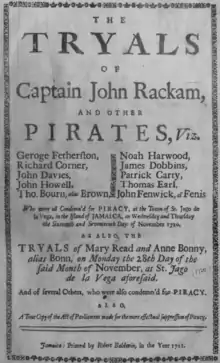Jonathan Barnet
Jonathan Barnet (fl. 1715–1720) was an English privateer active in the Caribbean. He is best known for capturing pirates Calico Jack, Anne Bonney, and Mary Read.
Jonathan Barnet | |
|---|---|
| Nationality | English |
| Occupation | Privateer |
| Years active | 1715–1720 |
| Known for | Capturing pirates Calico Jack, Anne Bonney, and Mary Read |
| Piratical career | |
| Base of operations | Caribbean |
| Commands | Tyger |

Biography
Lord Archibald Hamilton, Governor of Jamaica, commissioned ten privateers in late 1715 and charged them with hunting pirates. Among them was Barnet, who sailed out in his 90-ton snow Tyger.[lower-alpha 1][1] The Tyger's owners and Barnet posted bond before he sailed. Barnet's six-month commission was periodically renewed by Hamilton and succeeding Governors. Hamilton gave Barnet specific instructions on which flag to fly, on keeping a journal, and where to bring captured prize ships for confirmation,[1] as well as a warning: "You are not on any pretence to committ any acts of hostility, on any of H.M. allies, neuters, friends or subjects."[2]
In fact Barnet immediately joined the other privateers in raiding the wrecks of the 1715 Spanish Treasure Fleet. Jamaican Deputy Secretary Samuel Page initially blamed Barnet's actions on the sloop Barsheba captained by Henry Jennings, spurring a Spanish emissary to make an angry visit to Jamaica demanding action against the privateers. The Tyger's owners included Daniel Axtell, who also held shares of the privateer (and later pirate) vessels commanded by Leigh Ashworth, James Carnegie, and Samuel Liddell, all of which looted the Spanish wrecks as well.[2] After Barnet's raids came to light, Page was removed from office for consorting with pirates. Governor Hamilton himself was also recalled to England, replaced by Peter Heywood.[3] Governor Heywood would later fume against the rogue privateers who antagonized the Spanish under the flimsy pretense of privateering, remarking, "had not Comissions been granted which were given out on pretext of suppressing pyracys, these unhappy disorders had not been committed: and what was said to Jonathan Barnet (as will appear from his deposition) was too great an encouragement to be given to those sort of people."[4]
In 1716 Barnet testified against embattled Jamaican Governor Lord Archibald Hamilton, who was removed from office for consorting with pirates.[4] Barnet may have taken a 1717 pardon offered to all pirates who surrendered within a year: by 1720 his commission had been renewed yet again, this time by Heywood's replacement Governor Nicholas Lawes.[5] Barnet sailed late that year on a trading voyage alongside Jean Bonadvis, another former pirate and privateer turned pirate-hunter. Bonadvis spotted a sloop nearby and approached, only to be fired on. He retreated and reported the aggressor's location to Barnet, who left in pursuit.[6] Barnet hailed the vessel, whose drunken crew refused to surrender, and captured it after a brief battle.[7] The vessel turned out to be the William, captained by John "Calico Jack" Rackham, who had aboard two female pirates, Mary Read and Anne Bonney. The pirates were quickly tried and hanged, though the women managed avoid execution by claiming to be pregnant.[8] Lawes congratulated Barnet: "About a fortnight ago a trading sloop belonging to the Island, being well manned and commanded by a brisk fellow one Jonathan Barnet, did us a very good peice of service. He was met by a pirate vessel at the Leward part of this Island commanded by one Rackum in which were 18 pirates more, whom he took and are now in gaol..."[9]
See also
- Nicholas Brown, Robert Deal and Captain Thompson – three other pirates captured by Lawes' pirate-hunters
- Turn Joe – an Irish pirate who sailed in Spanish service and was caught by Jean Bonadvis
Notes
References
- Cordingly, David (2013). Under the Black Flag: The Romance and the Reality of Life Among the Pirates. New York: Random House Publishing Group. ISBN 9780307763075. Retrieved 28 July 2017.
- Headlam, Cecil (1930). America and West Indies: October 1717, 1-15 | British History Online (Vol30 ed.). London: His Majesty's Stationery Office. pp. 50–68.
- "Peter Heywood". baylusbrooks.com. Retrieved 15 December 2017.
- Headlam, Cecil (1930). America and West Indies: August 1716 | British History Online (Vol29 ed.). London: His Majesty's Stationery Office. pp. 159–177. Retrieved 15 December 2017.
- Little, Benerson (2016). The Golden Age of Piracy: The Truth Behind Pirate Myths. New York: Skyhorse Publishing, Inc. pp. 176–179. ISBN 9781510713048. Retrieved 15 September 2017.
- Cordingly, David (2011). Spanish Gold: Captain Woodes Rogers and the Pirates of the Caribbean. London: Bloomsbury Publishing. p. 234. ISBN 9780747599630. Retrieved 15 December 2017.
- Snow, Edward Rowe (1944). Pirates and Buccaneers of the Atlantic Coast. Dublin NH: Yankee Publishing Company. p. 305. Retrieved 15 December 2017.
- Woodard, Colin (2008). The Republic of Pirates: Being the True and Surprising Story of the Caribbean Pirates and the Man Who Brought Them Down. Orlando FL: Houghton Mifflin Harcourt. ISBN 978-0547415758.
- Headlam, Cecil (1933). America and West Indies: November 1720, 1-15 | British History Online (Vol32 ed.). London: His Majesty's Stationery Office. pp. 187–195. Retrieved 15 December 2017.
Further reading
- "The tryals of Captain John Rackam, and other pirates ....who were all condemn'd for piracy, at the town of St. Jago de la Vega, in the island of Jamaica, on Wednesday and Thursday the sixteenth and seventeenth days of November 1720. As also, the tryals of Mary Read and Anne Bonny .... and of several others, who were also condemn'd for piracy. Also, a true copy of the Act of Parliament made for the more effectual suppression of piracy." - Rackham's trial transcript with eyewitness accounts of the battle.
